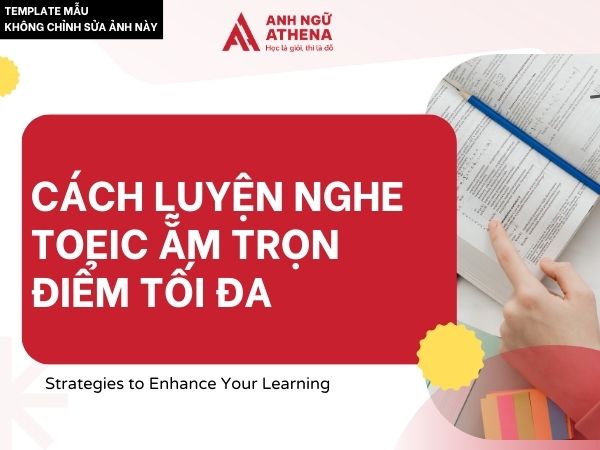Top 12 bài đọc IELTS theo các band điểm từ 0 - 7.5+ - vũ khí chinh phục bài thi IELTS READING
Chinh phục câu hỏi của từng dạng bài đọc IELTS theo các band điểm sẽ trở nên dễ dàng hơn nếu người học chịu “Start small, think bigs”. Đối với những người vừa mới bắt đầu tiếp xúc IELTS Reading, điều quan trọng nhất là xác định đúng trình độ và chọn cho mình tài liệu phù hợp để đọc. Nằm lòng 12 bài đọc IELTS theo các band điểm từ 0 - 7.5+ dưới đây sẽ giúp bạn chinh phục bài thi IELTS Reading “dễ như ăn bánh”!
THAM KHẢO NGAY KHOÁ HỌC IELTS TỪ 0 ĐẠT 6.5-8.0: TẠI ĐÂY

Khoá học IELTS từ 0 đạt 6.5-8.0 tại Anh ngữ Athena
1. Các dạng bài đọc phổ biến trong IELTS Reading
IELTS Reading được thiết kế với 40 câu hỏi và chia thành nhiều dạng bài. Tuy nhiên, trong bài viết này, Athena sẽ tổng hợp các dạng bài đọc IELTS phổ biến thường xuất hiện trong bài thi:
| DẠNG ĐỀ | CHI TIẾT |
| True/False/Not Given và Yes/ No/ Not Given | Cần phân biệt rõ 2 dạng đề này. Dạng đề T-F-NG dựa trên thông tin trong văn bản và người đọc hoàn toàn lấy đáp án từ đoạn văn trong bài thi. Tuy nhiên, đối với dạng đề Y-N-NG, người đọc phải suy luận và hiểu được những ẩn ý của tác giả kết hợp với thông tin trong bài để đưa ra đáp án chính xác. |
| Matching | Matching Headings: Đây được xem là dạng đề khó nhất trong số các dạng bài đọc IELTS theo các band điểm. Trong loại câu hỏi này, bạn sẽ phải đọc hiểu và hiểu rõ thông tin ở từng đoạn văn và đặt tiêu đề phù hợp với đoạn văn đó. Matching Information: Dạng bài yêu cầu người đọc tìm đoạn văn chứa thông tin được cho trong đề bài. Matching Features: Đề bài cung cấp tên riêng, danh từ riêng liên quan đến người, địa điểm hoặc thời gian và nhiệm vụ của bạn là nối những danh từ riêng ứng với từng thông tin được đưa ra. |
| Multiple Choices | Dạng bài này thường xuất hiện trong Part 3 của IELTS Reading. Bạn sẽ phải chọn một trong số các phương án đáp án được đưa ra. Câu hỏi sẽ thường xoay quanh như chủ đề của đoạn văn, ngụ ý của đoạn văn, ngụ ý tác giả. |
| Sentence Completion | Dạng bài này cực kỳ phổ biến trong Part 1 và Part 3 của IELTS. Người học vừa kết hợp tra cứu thông tin từ đề bài, vừa xác định keywords chính để điền vào chỗ trống của câu hỏi. |
Tìm hiểu thêm:
Hướng dẫn chi tiết cách “ẵm trọn” điểm cao trong đề bài multiple choice IELTS Listening
Bỏ túi 10+ sách luyện IELTS Writing cực hiệu quả từ 0-7.5+
2. Phân loại bài đọc IELTS theo các band điểm
Làm thế nào để học IELTS Reading hiệu quả cho những người mới bắt đầu? Câu trả lời chính xác nhất là bạn cần xác định được trình độ hiện tại của mình và kết hợp với việc tìm hiểu các tài liệu luyện tập phù hợp với khả năng hiện tại. Ví dụ: nếu như mất gốc Tiếng Anh, việc luyện tập qua các bài đọc IELTS Reading rất khó, thay vào đó người học có thể bắt đầu với các đoạn văn ngắn hoặc các mẫu truyện đơn giản. Athena gửi đến bạn bộ tài liệu bài đọc IELTS theo các band điểm từ 0 - 7.5+, giúp bạn tự tin với kỹ năng Reading của mình:
Bài đọc IELTS cho band điểm <3.0
The value of friendship
Recent research into the world of teenagers has suggested that they value friendship above everything else. Children aged between 12 and 15 were asked what was important to them. Their answers included possessions such as money and computer gadgets but also relationships with people. The teenagers questioned said that friends were the most important to them, more even than family, or boyfriends and girlfriends.
We wanted to find out more about the results of this research so we asked our readers what they thought about the value of friendship. Here are some examples of what they said about their friends.
Ben, 15: Every time I have a fight with my parents, I need some time on my own. But after that, the first thing I do is meet up with my friends. After playing football for a while, or skateboarding, I usually feel much happier again.
Rory, 13: When I moved to a village in the countryside, I thought that it would be the end of my friendships. But my old friends have kept in touch and they come and visit in the holidays. There's a lake nearby, so we often go sailing, water-skiing or windsurfing. And I have made some new friends here too, at school, and since I joined the rugby club.
Carlos, 11: Last year, I broke my arm on a skiing holiday. Unfortunately, it was my left arm and I am left- handed. My school friends all helped and copied their notes for me.
It seems that our readers value their friendships very highly. From what they told us, they spend a lot of time with their friends, just hanging out, or sharing hobbies and interests. They seem to need their friends for advice, help, chats, and for having fun. Clearly, friends make each other feel better. Looking at what our readers told us, the results of the recent research are not really surprising.
Now answer these multiple-choice questions. Choose the appropriate letter a, b, c or d.
1. Why are Ben, Rory and Carlos mentioned in the article?
They know why teenagers value friendship.
They gave information about themselves.
They read magazines.
They are teenage boys.
2. Which of the following best describes Ben?
He often has fights.
He is happier than his friends.
He likes being alone
He likes sports
3. What do we know about the lake that Rory visits?
He likes being alone.
It is near the school b It is near his home.
It is used by a lot of people who do water sports
It is in a village
4. Carlos mentions that he is left-handed because
It makes skiing harder
It makes it worse that he broke the arm he uses most.
It is an interesting fact about himself and he was talking about his left arm.
It is very unfortunate when you break your arm.
Đáp án:
1.B
2.D
3.C
4.B
Tham khảo:
Bộ tài liệu IELLS Reading căn bản
Tổng hợp bộ 1000 từ vựng IELTS 5.0-6.5 và nguồn sách tham khảo

Tom’s job
Tom works at a bank. He is the manager. He starts work every day at 8:00 am. He finishes work every day at 6:00 pm. He lives very close to the bank. He walks to work every day. His brother and sister also work at the bank. But, they do not live close to the bank. They drive cars to work. They start work at 9:00 am. In the bank, Tom is the boss. He helps all the workers and tells them what to do. He likes his job. He is also very good at his job. Many customers like Tom, and they say hello to him when they come to the bank. Tom likes to talk to the customers and make them feel happy. Tom really likes his job.
Where does Tom work?
a) A school
b) A restaurant
c) A bank
d) A hospital
2. What time does Tom start work every day?
a) 7:00 am
b) 8:00 am
c) 9:00 am
d) 10:00 am
3. How does Tom go to work?
a) He drives a car
b) He rides a bicycle
c) He walks
d) He takes the bus
4. In the passage, it is mentioned that Tom's brother and sister:
a) Work at different banks
b) Walk to work like Tom
c) Live close to the bank
d) Drive cars to work
5. What is Tom's role at the bank?
a) Customer
b) Worker
c) Manager
d) Janitor
Đáp án:
A
B
C
D
C
File tài liệu: Link
Bài đọc IELTS cho band điểm 3.0 - 4.0
Online friendships
It is said that most people have no more than 30 friends at any given time, and 400 over the whole of their lives. However, on social networking sites, most users have about 150 friends. If these numbers are correct, then friendship means different things in different situations.
One of the reasons for having more online friends than real friends at a certain point in time is that online friendships do not require much time and energy: it is easy to accept friendships and keep them forever. Another possibility is that it is difficult to say 'no' when somebody asks us to be their friend online, even if we feel we don't really know them. The fact that they ask us suggests that they do consider us a friend, which is a nice feeling. Alternatively, they may be 'collectors' of online friends and just want to use us to get a higher number of friends and appear to be popular.
Online friendships are quite easy, but in the real world decisions about friendships are harder to make. There are no rules about friendship. There are no guidelines about how to make friends, how to keep friendships going, and how to finish friendships if we want to move on. People have very different opinions about this: some people would die for their friends and they value them more than family. Others say that friends are temporary, only there to help each other until they are no longer needed. If people with such different views become friends, this can lead to problems.
Because of these different definitions of friendship, it is easy to be unhappy about our friendships. We may want them to be deeper or closer, or we may want to have more friends in our lives. Sometimes we simply do not have the time to develop our friendships, or we fear we have left it too late in life to start. If we move to another country or city, we have to find ways to make new friends again.
This dissatisfaction shows us how important friendships are for most of us. We should not think that it could be too late to build friendships. We also need to understand that the need to be around other people is one that is shared by many. Therefore, we should not be too frightened about starting to talk to people who in the future may become our friends: it is likely that they too would like to get closer to us. Remember what people say: strangers are friends we have not met yet.
Questions 1-6
Choose the appropriate letters a, b, c or d.
1. How many friends do the majority of people probably have?
30 real friends or fewer
A minimum of 30 real friends
150 internet friends
400 internet friends over the course of their lives
2. It is difficult...
To believe the numbers about friendship.
To keep your friends happy
To trust what you read on social networking sites.
To give a definition of 'friendship
3. Friendship means...
Different things to different people.
Dying for your friends if you need to.
Helping each other until it is no longer necessary
Accepting people with different views.
4. Sometimes people worry because…
They think that they have too many friends
They spend too much time with friends
They think they are too old to make friends.
There are no guidelines about friendship.
5. Most of us.
Are dissatisfied with our friends.
Build friendships late in life.
Are frightened to talk to strangers
Need to be with others.
6. What does 'Strangers are friends we have not met yet' mean?
We have not met strangers before.
Strangers are also our friends.
We should not talk to strangers.
Strangers may become our friends.
Đáp án:
A
D
A
C
D
D
The Peace Corps
On March 1, 1961, President John F. Kennedy issued an order creating the Peace Corps.
Its mission was to promote world peace and friendship by providing qualified volunteers
to interested countries. Today it sends an average of 6,000 U.S. citizens abroad each year.
Volunteers live at a local level in their host countries. They are paid in local currency.
Each month they receive a small sum of money that covers basic living expenses, and varies
with the local economy. For example, volunteers in Micronesia make the equivalent of
$300 per month, while those in Turkmenistan make $75. Most volunteers live with host
families. This is a great chance to learn the language and the culture.
For each month that they spend overseas, volunteers receive a sum of about $200. This
money helps them to get back on their feet in the United States.
Serving countries all over the world, the Peace Corps lives up to its promise as "the
toughest job you'll ever love." Volunteers do everything from teaching English to sharing
tips on growing food to provide preventive health care. However, the application process
to become a Peace Corps volunteer is very competitive. You must be a U.S. citizen, at least
eighteen years old, in good health, and willing to serve for two years. Nearly all volunteers
have a bachelor's degree in their chosen field, and about 18 percent have their master's or
doctorate degrees. Knowing a language, especially French and Spanish, helps.
Read the passage The Peace Corps and answer the following questions with NO MORE THAN THREE WORDS taken from the passage.
What kind of U.S. citizens does the Peace Corps send abroad to fulfill its mission?
What does the monthly payment in local currency to volunteers cover?
Whom do the volunteers stay with in their host countries?
What is the shortest time that volunteers can work for the Peace Corps?
Which languages are given as an example of what can benefit volunteers?
Đáp án:
qualified volunteers
basic living expenses
host families
two years
French and Spanish

Bài đọc IELTS cho band điểm 4.0 - 5.0
A city survey with a difference
There are many websites on the Internet which provide lists of the world's best cities to visit, live or work in. These lists usually grade the cities in order, from 'best' to 'worst', and are based on facts and figures provided by local or national organisations.
The City Brands Index (CBI) also provides a list of best and worst cities. However, unlike other surveys, it is based on the idea that cities are similar to products in shops. It asks ordinary people in other countries to grade cities in the same way that they would grade a product, like a soft drink or a car. What is particularly different about the CBI is that the people who take part in the survey may not have ever visited the cities. Instead, they are asked to say what they think the cities are like, basing their opinions on things like news stories, magazine articles or television programmes they have heard or seen.
Each year, about 10,000 people in 20 countries take part in the CBI survey, and they grade a total of 50 cities. They do this by filling in an online questionnaire. There are several categories in the survey. These include things like the economy, education, the environment, local culture, climate and what the city's residents are like.
The CBI list is useful because it helps people choose a good place to live, find work or take a holiday. It also helps regional governments to understand why people and businesses are, or are not, coming to their cities, and so shows them areas which they could develop or improve.

File tài liệu: Link
Now complete the notes below. Choose ONE WORD OR A NUMBER from the passage for each answer.
The City Brands Index
The CBI believes that cities are like 1…………… which people can buy when they go shopping.
Surveys take place every 2 …………… .
A maximum of 3…………… cities are included in the survey.
A number of different 4 …………… are included in the survey.
The CBI list is helpful for:
people who are trying to decide where to 5 …………… or get a job.
people who are looking for a good 6……………destination.
local 7…………… who want to make their city a better place.
Đáp án:
products
year
50
categories
live
holiday
governments
Bài đọc IELTS cho band điểm 5.0 - 6.0
Australian culture and culture shock by Anna Jones and Xuan Quach
Sometimes work, study or a sense of adventure take us out of our familiar surroundings to go and live in a different culture. The experience can be difficult, even shocking.
Almost everyone who studies, lives or works abroad has problems adjusting to a new culture. This response is commonly referred to as ‘culture shock’. Culture shock can be defined as ‘the physical and emotional discomfort a person experiences when entering a culture different from their own’ (Weaver, 1993).
For people moving to Australia, Price (2001) has identified certain values which may give rise to culture shock. Firstly, he argues that Australians place a high value on independence and personal choice. This means that a teacher or course tutor will not tell students what to do, but will give them a number of options and suggest they work out which one is the best in their circumstances. It also means that they are expected to take action if something goes wrong and seek out resources and support for themselves.
Australians are also prepared to accept a range of opinions rather than believing there is one truth. This means that in an educational setting, students will be expected to form their own opinions and defend the reasons for that point of view and the evidence for it.
Price also comments that Australians are uncomfortable with differences in status and hence idealise the idea of treating everyone equally. An illustration of this is that most adult Australians call each other by their first names. This concern with equality means that Australians are uncomfortable taking anything too seriously and are even ready to joke about themselves.
Australians believe that life should have a balance between work and leisure time. As a consequence, some students may be critical of others who they perceive as doing nothing but study.
Australian notions of privacy mean that areas such as financial matters, appearance and relationships are only discussed with close friends. While people may volunteer such information, they may resent someone actually asking them unless the friendship is firmly established. Even then, it is considered very impolite to ask someone what they earn. With older people, it is also rude to ask how old they are, why they are not married or why they do not have children. It is also impolite to ask people how much they have paid for something, unless there is a very good reason for asking.
Kohls (1996) describes culture shock as a process of change marked by four basic stages.
During the first stage, the new arrival is excited to be in a new place, so this is often referred to as the “honeymoon” stage. Like a tourist, they are intrigued by all the new sights and sounds, new smells and tastes of their surroundings. They may have some problems, but usually they accept them as just part of the novelty. At this point, it is the similarities that stand out, and it seems to the newcomer that people everywhere and their way of life are very much alike. This period of euphoria may last from a couple of weeks to a month, but the letdown is inevitable.
During the second stage, known as the ‘rejection’ stage, the newcomer starts to experience difficulties due to the differences between the new culture and the way they were accustomed to living. The initial enthusiasm turns into irritation, frustration, anger and depression, and these feelings may have the effect of people rejecting the new culture so that they notice only the things that cause them trouble, which they then complain about. In addition, they may feel homesick, bored, withdrawn and irritable during this period as well.
Fortunately, most people gradually learn to adapt to the new culture and move on to the third stage, known as ‘adjustment and reorientation’. During this stage a transition occurs to a new optimistic attitude. As the newcomer begins to understand more of the new culture, they are able to interpret some of the subtle cultural clues which passed by unnoticed earlier. Now things make more sense and the culture seems more familiar. As a result, they begin to develop problem-solving skills, and feelings of disorientation and anxiety no longer affect them.
In Kohls’s model, in the fourth stage, newcomers undergo a process of adaptation. They have settled into the new culture, and this results in a feeling of direction and self-confidence. They have accepted the new food, drinks, habits and customs and may even find themselves enjoying some of the very customs that bothered them so much previously. In addition, they realize that the new culture has good and bad things to offer and that no way is really better than another, just different.
Questions 1–6 Do the following statements agree with the information given in the reading passage?
Write
TRUE if the statement agrees with the information
FALSE if the statement contradicts the information
NOT GIVEN if there is no information on this
Australian teachers will suggest alternatives to students rather than offer one solution.
In Australia, teachers will show interest in students’ personal circumstances.
Australians use people’s first names so that everyone feels their status is similar.
Students who study all the time may receive positive comments from their colleagues.
It is acceptable to discuss financial issues with people you do not know well.
Younger Australians tend to be friendlier than older Australians.
Đáp án:
TRUE
FALSE
TRUE
FALSE
FALSE
NOT GIVEN
Nguồn tài liệu: Link

Organic Food: Why
Today, many governments are promoting organic or natural farming methods that avoid the use of pesticides and other artificial products. The aim is to show that they care about the environment and about people's health. But is this the right approach?
Europe is now the biggest market for organic food in the world, expanding by 25 percent a year over the past 10 years. So what is the attraction of organic food for some people? The really important thing is that organic sounds more 'natural'. Eating organic is a way of defining oneself as natural, good, caring, different from the junk-food-scoffing masses. As one journalist puts it: 'It feels closer to the source, the beginning, the start of things.' The real desire is to be somehow close to the soil, to Mother Nature.
Unlike conventional farming, the organic approach means farming with natural, rather than man-made, fertilisers and pesticides. Techniques such as crop rotation improve soil quality and help organic farmers compensate for the absence of man-made chemicals. As a method of food production, organic is, however, inefficient in its use of labour and land; there are severe limits to how much food can be produced. Also, the environmental benefits of not using artificial fertiliser are tiny compared with the amount of carbon dioxide emitted by transporting food (a great deal of Britain's organic produce is shipped in from other countries and transported from shop to home by car.
Organic farming is often claimed to be safer than conventional farming- for the environment and for consumers. Yet studies into organic farming worldwide continue to reject this claim. An extensive review by the UK Food Standards Agency found that there was no statistically significant difference between organic and conventional crops. Even where results indicated there was evidence of a difference, the reviewers found no sign that these differences would have any noticeable effect on health.
The simplistic claim that organic food is more nutritious than conventional food was always likely to be misleading. Food is a natural product, and the health value of different foods will vary for a number of reasons, including freshness, the way the food is cooked, the type of soil it is grown in, the amount of sunlight and rain crops have received, and so on. Likewise, the flavour of a carrot has less to do with whether it was fertilised with manure or something out of a plastic sack than with the variety of carrot and how long ago it was dug up. The differences created by these things are likely to be greater than any differences brought about by using an organic or non- organic system of production. Indeed, even some 'organic' farms are quite different from one another.
The notion that organic food is safer than normal food is also contradicted by the fact that many of our most common foods are full of natural toxins. Parsnips cause blisters on the skin of agricultural workers. Toasting bread creates carcinogens. As one research expert says: "People think that the more natural something is, the better it is for them. That is simply not the case. In fact, it is the opposite that is true: the closer a plant is to its natural state, the more likely it is that it will poison you. Naturally, many plants do not want to be eaten, so we have spent 10,000 years developing agriculture and breeding out harmful traits from crops.
Yet educated Europeans are more scared of eating traces of a few, strictly regulated, man-made chemicals than they are of eating the ones that nature created directly. Surrounded by plentiful food, it's not nature they worry about, but technology. Our obsessions with the ethics and safety of what we eat-concerns about antibiotics in animals, additives in food. GM crops and so on-are symptomatic of a highly technological society that has little faith in its ability to use this technology wisely. In this context, the less something is touched by the human hand, the healthier people assume it must be.
Ultimately, the organic farming movement is an expensive luxury for shoppers in well-manicured Europe. For developing parts of the world, it is irrelevant. To European environmentalists, the fact that organic methods require more labour and land than conventional ones to get the same yields is a good thing; to a farmer in rural Africa, it is a disaster. Here, land tends to be so starved and crop yields so low that there simply is not enough organic matter to put back into the soil. Perhaps the focus should be on helping these countries to gain access to the most advanced farming techniques, rather than going back to basics
Questions 1-7
The reading passage has seven paragraphs, A-G. Choose the correct heading for paragraphs B-G from the list of headings below.
List of Headings
Research into whether organic food is better for us
Adding up the cost of organic food
The factors that can affect food quality
The rich and poor see things differently
A description of organic farming
Testing the taste of organic food
vii. Fear of science has created the organic trend
The main reason for the popularity of organic food
The need to remove hidden dangers from food
Đáp án:
| 1. v |
| 2. i |
| 3. iii |
| 4. ix |
| 5. vii |
| 6. iv |
Bài đọc IELTS cho band điểm 6.0 - 7.0
An invention to dye for: the colour purple
A 19th century research chemist was trying to make medicine when, instead, he came up with a coloured dye that has ensured the world is a brighter place.
A. Of all the colours, purple has perhaps the most powerful connotations. From the earliest cultures to the present day, people have sought to harness its visual power to mark themselves out as better than those around them. From bishops to kings, pop stars to fashion models, its wearing has been a calculated act of showing off. In ancient Rome, for example, purple was such a revered colour that only the emperor was allowed to wear it. Indeed, an emperor who was referred to as porphyrogenitus, ('born to the purple') was especially important, since this meant that he had inherited his position through family connections rather than seizing power through military force.
B But why purple? At that time, purple dye was an expensive substance produced in a complicated, foul-smelling and time-consuming process. This involved boiling thousands of molluscs in water in order to harvest their glandular juices. The technique had originally been developed by the Phoenicians over a thousand years previously, and it hadn't changed since. Cheaper but poorer quality purple dyes could be made from lichens using an equally messy and unpleasant procedure, but they were not as bright, and the colour quickly faded. It was no surprise, therefore, that good purple dye was a rare and precious thing, and clothes dyed purple were beyond the financial means of most people.
C However, times have changed. In the great consumer democracy of the 21st century, even the most humble citizen can choose it as the colour of their latest outfit. For that privilege, we must thank a young 19th century research chemist, William Perkin. A talented 15-year-old when he entered the Royal College of Chemistry in London in 1853, Perkin was immediately appointed as laboratory assistant to his tutor, August Wilhelm von Hofmann. He became determined to prove Hofmann's claim that quinine, a drug used to treat fevers such as malaria, could be synthesised in a laboratory. However, rather than the cure desperately needed for people dying from malaria in tropical countries, he produced little more than a black, sticky mess that turned purple when dissolved in industrial alcohol. Perkin's experiments could have been a complete waste of time, but to his surprise and, ultimately, financial benefit, his purple liquid turned out to be a long-lasting dye that was to transform fashion.
D Perkin repeated his experiments in an improvised laboratory in his garden shed, perfecting the process for making the substance he had called mauveine after the French mallow plant. It was, says Simon Garfield, the author of Mauve which details Perkin's life and work, an astonishing breakthrough. 'Once you could do that you could make colour in a factory from chemicals rather than insects or plants. It opened up the prospect of mass-produced artificial dyes and made Perkin one of the first scientists to bridge the gap between pure chemistry and its industrial applications.' It didn't take long for the chemist, still only 18, to capitalize on his creation, patenting the product, convincing his father and brother to back it with savings, and finding a manufacturer who could help him bring it rapidly to the market. The buying public loved it, and clothes coloured with purple started appearing in shops up and down the country.
Appropriately, considering the origins of Perkins' colour, he was to receive a helping hand from the two most important women of the day. Queen Victoria caused a sensation when she stepped out at the Royal Exhibition in 1862 wearing a silk gown dyed with mauveine. In Paris, Napoleon III's wife, Empress Eugenie, amazed the court when she was seen wearing it. To propel the scientist further on the way to a great fortune, the fashion of the time was for broad skirts that, happily for him, needed a lot of his revolutionary new dye.
E Perkins, ever the serious scientist, would have been among the first to point out that his mauve is just one of a range of colours described in everyday language as purple. Not itself a true colour of the spectrum- that position is given to indigo and violet - purple normally refers to those colours which inhabit the limits of human perception in the area between red and violet. Newton excluded the colour from his colour wheel. Scientists today talk about the 'line of purples' which include violet, mauve, magenta, indigo and lilac.
F In the alternative medical practice of colour therapy, which practitioners say can trace its origins back to ancient India, the 'purple range' colours of indigo and violet are vital. They refer to spiritual energy centres known as chakras and are situated in the head. The colours and their 'medical' qualities were first officially listed by the Swiss scientist Dr Max Luscher, who said that appropriately coloured lights, applied to specific chakras, could treat ailments from depression to grief. Julia Kubler is one of Britain's leading colour therapists and has been using colours to treat patients at her clinic at Manningtree, Essex, for 15 years. Purple, she says, 'is consistent with intuition and higher understanding, with spirituality and meditation. It combines the coolness of blue with a bit of red that makes it not just passive but active."
It is hardly the most outlandish of claims for this most enigmatic of colours. Variously touted as the colour of everything from insanity to equality. it is enjoying a new role as the symbol of political compromise. Purple may have had its origins in the ancient world, but thanks to a young chemist, it still has a brilliant future.
Look at Questions 1-14 below, and underline the key words and phrases. Then look for the answers in the passage.
Questions 1-6
The reading passage has six sections, A-F.
Choose the correct heading for each section from the list of headings below.
List of headings
From the laboratory to the High Street
Seeking royal support
An unexpected but fortunate side result
The healing power of purple
An old problem
Standing out from the crowd
Finding an alternative cure for a common illness
Part of a larger family
An ancient manufacturing practice
Section A ……………
Section B ……………
Section C ……………
Section D ……………
Section E ……………
Section F……………
Questions 7-10
Choose TWO letters, A-E.
Questions 7-8
What TWO points does the writer make about the colour purple and purple dye before William Perkin's creation?
It was only used to colour clothes.
It was originally produced for Roman emperors.
It was not easy to make.
There were many different techniques used to make it.
Some purple dyes were inferior to others.
Đáp án:
Vi
V
Vii
I
Viii
Iv
C
E
Nguồn tài liệu: Link

The World Wide Web from its origins
Information Management: A Proposal. That was the bland title of a document written in March 1989 by a then little- known computer scientist called Tim Berners-Lee, who was working at CERN, Europe's particle physics laboratory, near Geneva. His proposal, modestly called the World Wide Web, has achieved far more than anyone expected at the time.
In fact, the Web was invented to deal with a specific problem. In the late 1980s, CERN was planning one of the most ambitious scientific projects ever, the Large Hadron Collider", o

![[HOT] Trọn bộ IELTS Speaking Sample Quý 3 band 7.0+ PDF](https://anhnguathena.vn/anhngu//img.media/2023/11/1699877641192.png?v=1.0.0)
![[PDF + Review] Bộ tài liệu Basic IELTS Reading](https://anhnguathena.vn/anhngu//img.media/2023/11/1698991112335.png?v=1.0.0)











![[Cập nhật] Lịch thi TOEIC 2025 Quý 1 tại IIG Việt Nam](https://anhnguathena.vn/upload/ban-sao-cua-template-bai-viet-seo-6.png?v=1.0.0)





